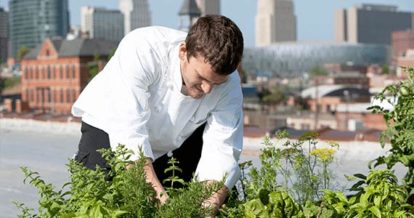Creating a sustainable restaurant menu is one of the best things you can do for the planet and for your bottom line.
According to the 2020 study by Tastewise, 23% more Americans make food and beverage decisions based on sustainability considerations than a year ago. And customers are willing to pay up for these changes – another study found that more than two-thirds of customers would be willing to pay extra money for green restaurant practices. In other words, an environmentally friendly menu is quickly becoming an expectation and creating one can give your revenue a nice boost.
But while going green is more popular than ever before, it’s not as simple as banning plastic straws or adding veggie burgers to the menu. A sustainable restaurant is one that makes a meaningful effort to reduce its impact on the environment through waste reduction, energy conservation, and more.
To help you create a sustainable restaurant menu that makes an impact on the plant and your bottom line, this article will cover:
- How to know if your menu is sustainable
- The benefits of creating a sustainable restaurant menu
- 13 ways to make your own menu more sustainable
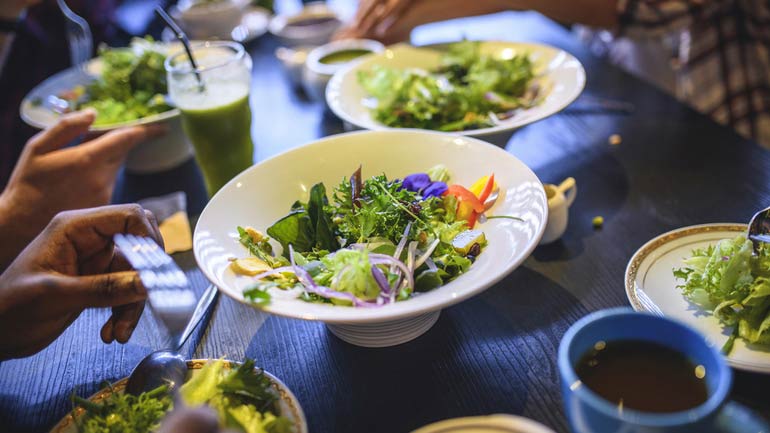
The Benefits of a Sustainable Restaurant Menu
As mentioned above, a sustainable restaurant menu can give your bottom line a nice little boost. However, that’s not the only reason you should overhaul your offerings.
- Reduced Operating Costs: According to a study by Pacific Gas and Electric’s Food Service Technology Center, 80% of the $10 billion annual energy bill for the commercial food service sector is spent on inefficient food cooking, holding, and store equipment. As a result, sustainable practices could reduce restaurant operating costs by up to 30%.
- Reduce Employee Turnover: People don’t just choose brands based on their values – they also choose workplaces that align with their personal values. Your staff are more likely to stick around when your restaurant practices are implemented in similar values, like sustainability.
- Attract New Customers: The National Restaurant Association found that sustainability is a particularly hot topic among Millennials, with 58% saying they are “more likely to choose one restaurant over another based on its ability to provide sustainably grown, raised and manufactured foods.”
- Marketing Opportunities: Branding your restaurant as a sustainable venue can help set your venue apart from the competition and garner positive media attention.
- Good for the Planet: It goes without saying that efforts to save energy, reduce waste, and implement other sustainable practices have a positive impact on the planet.

Strategic menu design has been proven to grow profits by 15%.
Is Your Menu Sustainable?
Before you compost your old menu like a loaf of stale bread, think carefully about your current offerings. Just because it isn’t sustainable right now, doesn’t mean you have to scrap the whole thing. It may be a matter of implementing some greener practices to your current offering.
Take a look at your menu and ask yourself the following questions:
- Are your ingredients sourced from local and organic suppliers?
- Is your menu adaptable to seasonal changes?
- Are your portions sized correctly?
- Are you conscious of food waste?
- Do you grow any of your own ingredients?
If you answered no to any – or all! – of the above questions, your menu isn’t as sustainable as it could be. This means you could be losing money due to food waste, higher food costs, and potential lost business as well – not to mention the negative environmental impacts an unsustainable menu creates.
But it also means there’s some great opportunities to make sustainable changes.
How to Make Your Menu Sustainable
Feeling inspired to make some eco-friendly changes?
If you want to go green, here are 15 of the top tips for creating a menu that’s more sustainable. Whether you implement one or all of these, every little bit will make a difference!
1. Localize Your Supply Chain
The farm-to-table movement has been making waves in the restaurant industry and it shows no sign of slowing down. Take cues from this shift by sourcing produce and ingredients locally from farmer’s markets or suppliers who buy from local farmers. Not only will this cut down on transportation costs and pollution, but it will also ensure your local farmers are supported.
In addition, local food is proven to be fresher because the distance between the farm to your kitchen to your customer’s fork is shorter – win-win!
2. Update Your Menu Seasonally
Sync your menu with seasonal produce (meaning food grown at the same time of the year you consume it) to adapt your menu to the flow of nature, and purchase food at its peak supply. In-season produce is generally grown closer to where it’s sold, meaning it won’t travel across the world or spoil on its way to your kitchen. Now, this isn’t to suggest you should totally rewrite your menu every season (although you certainly can), but you should swap in seasonal produce when possible.
3. In-House Production
If you really want to separate your restaurant and menu offerings from every other restaurant in the neighborhood while going green, make some of your own items in-house. You could pickle your own vegetables or make your own salad dressings from fresh ingredients. With in-house production, your dishes will come out with a fresh, homemade taste and be sustainable to boot!
4. Start an Onsite Garden
You can start an onsite garden almost anywhere – in a backyard, a rooftop, or on a window sill. This could be as simple as a small herb garden with chives, mint, rosemary, and parsley, or a more complex garden full of seasonal fruits and vegetables. One of the major benefits of having an onsite garden is you can control what you grow, and you’ll have a selection of homegrown ingredients onsite at all times.
Starting a garden will also result in less spend on produce and increased profits for your venue. Temporis, a Michelin star restaurant in Chicago, does this right on site with a garden in their basement.
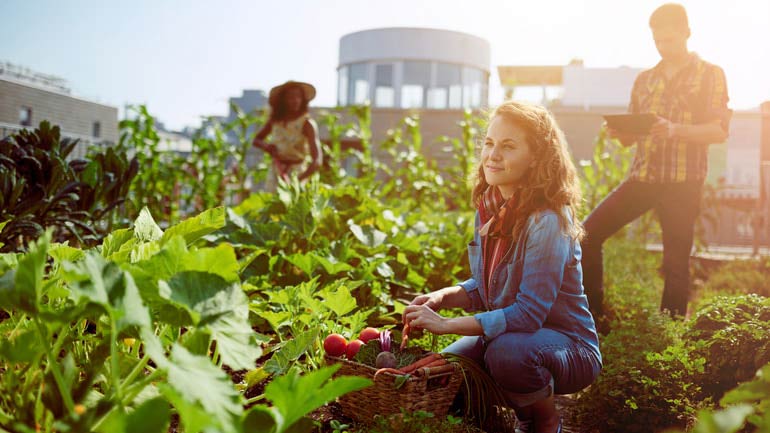
5. Reduce Portion Sizes
While supersized portions have become the norm for many Western countries, much of that food ends up in the trash. A quick and easy way to reduce portion sizes is by using smaller plates.
On a smaller plate, even when you serve less food it will still look full to your customers – resulting in a satisfying optical illusion for patrons (not to mention a healthy serving of food) and immediate savings for you.
6. Serve Less Meat
Reduce the amount of meat – both the serving sizes and the amount you serve to three ounces or less (this is the correct serving size of protein for an adult) per plate. Opt instead to serve increased portions of vegan and vegetarian options.
On average it takes about 1,800 gallons of water to harvest a single pound of meat, and the meat industry is responsible for around one-fifth of the man-made greenhouse gasses, which are directly contributing to climate change. Cutting back meat portions will make your menu more sustainable and benefit the planet as well!
7. Shrink Your Menu
In the case of a restaurant’s menu, less is truly more. Instead of trying to give dozens of dishes a green makeover, shrink your menu down to a few sustainable standouts. With fewer dishes to prepare, chefs can fully hone their efforts and make each dish as sustainable as possible. A smaller menu is also less intimidating to customers and makes for an easier decision-making process.

Strategic menu design has been proven to grow profits by 15%.
8. Reduce Food Waste
Reducing your portion sizes is one way to keep food out of the garbage, but it’s not the only way.
Start by conducting a food audit by asking your staff to sort food waste into different bins for spoiled food, kitchen scraps, and customer waste. Once you know how much is being wasted, look for ways to reduce spoilage and repurpose kitchen scraps. For instance, animal bones can easily be used to make stock, while stale bread is perfect for croutons – incorporate those into your menu to reduce waste and change up your offerings!
To cut back on food that’s wasted after it’s left your kitchen, use a menu management system to identify unpopular dishes and remove items that don’t sell. You can also make it easier for guests to take leftovers home by offering takeout containers.
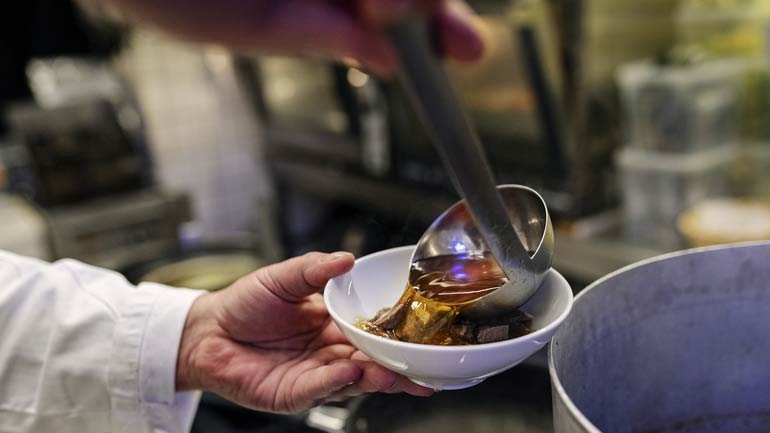
9. Go Organic
Unlike conventional farming, organic farming has a number of benefits for the environment:
- Builds healthy soil that can maintain nutrients and protect against erosion
- Helps to conserve and protect the water supply
- Encourages healthy biodiversity
- Produces less air pollution
With so many benefits for the environment, choosing organic ingredients can be a great way to make your restaurant more sustainable.
You don’t have to stop at produce. The organic wine market is booming and experts predict that 1 billion bottles of organic wine will be consumed around the world each year by 2022.
10. Buy in Bulk
While less is usually more when it comes to sustainability, that isn’t always the case. For some ingredients, it can be less wasteful to buy in bulk – think dry pasta, nuts, spices.
Even in the case of fresh ingredients, you can purchase local produce in bulk when it’s in peak season and then find creative ways to use it such as drying, freezing, or preserving it. When you buy these menu ingredients in bulk, it means less emission on getting food delivered.
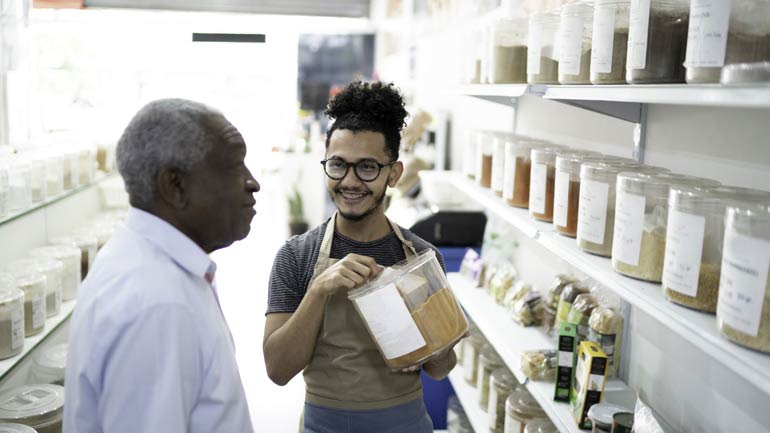
11. Partner with the Community
Your commitment to sustainability shouldn’t end with your restaurant. Extend your mission to the larger community by teaming up with community gardens programs or local farms. For instance, you could create a special menu made from produce grown in a neighborhood garden. Or you could host a cooking class at a nearby farm to showcase how different ingredients go from the farm to your table.
12. Ditch Disposable Packaging
“Can you wrap this up?”
Customers often want to take their leftovers home, which means you need to think about how these green menu efforts need to extend to how people are transporting your food. Think you can get away with styrofoam packaging for a few more years? Think again.
Today’s eco-conscious consumers are keenly aware of packaging waste and they expect restaurants to take the issue seriously – just look at the response to plastic straws.
With this in mind, take a look at sustainable packaging alternatives for your takeout and delivery orders. This can mean making the simple switch from plastic to cardboard, or using fully biodegradable packaging. You can even go a step further by partnering with a company like GO Box that supplies, collects, and cleans reusable takeout boxes.
13. Think Beyond Food
You may have created a fully sustainable restaurant menu, but your work shouldn’t end there. Think beyond food to consider other ways you can go green at your business overall.
In many cases, you can find reclaimed materials like flooring, fixtures, and restaurant furniture, instead of purchasing something brand new. And in the case that upcycling is not an option, you can still look for sustainable alternatives like swapping your paper napkins for cloth napkins.
Creating a sustainable restaurant menu doesn’t have to be a daunting task – it can be fun, exciting, and profitable. Try our 13 suggestions and let the green roll in!
Download our free inventory template
Sign up for our free weekly TouchBistro Newsletter

